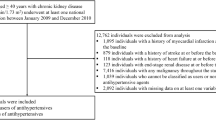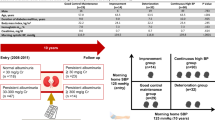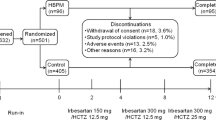Abstract
The hypertensive and normotensive Appropriate Blood Pressure Control in Diabetes (ABCD) studies were prospective, randomized, interventional clinical trials with 5 years of follow-up that examined the role of intensive versus standard blood pressure control in a total of 950 patients with type 2 diabetes mellitus. In the hypertensive ABCD study, a significant decrease in mortality was detected in the intensive blood pressure control group when compared with the standard blood pressure control group. There was also a marked reduction in the incidence of myocardial infarction when patients were randomly assigned to initial antihypertensive therapy with angiotensin-converting-enzyme inhibition rather than calcium channel blockade. The results of the normotensive ABCD study included associations between intensive blood pressure control and significant slowing of the progression of nephropathy (as assessed by urinary albumin excretion) and retinopathy, and fewer strokes. In both the hypertensive and normotensive studies, mean renal function (as assessed by 24 h creatinine clearance) remained stable during 5 years of either intensive or standard blood pressure intervention in patients with normoalbuminuria (<30 mg/24 h) or microalbuminuria (30–300 mg/24 h) at baseline. By contrast, the rate of creatinine clearance in patients with overt diabetic nephropathy (>300 mg/24 h; albuminuria) at baseline decreased by an average of 5 ml/min/year in spite of either intensive or standard blood pressure control. Analysis of the results of 5 years of follow-up revealed a highly significant correlation of all-cause and cardiovascular mortality with left ventricular mass and severity of albuminuria.
Key Points
-
The primary hypothesis of the 5-year prospective Appropriate Blood Pressure Control in Diabetes (ABCD) trial was that intensive (as opposed to moderate) control of blood pressure, via randomization to either nisoldipine or enalapril treatment, would prevent or slow the progression of diabetic complications and cardiovascular events in individuals with type 2 diabetes mellitus
-
The prevalences of diabetic complications and cardiovascular disease at baseline were significantly greater among enrollees whose diastolic blood pressure exceeded 90 mmHg; trial data for the hypertensive and normotensive cohorts were, therefore, analyzed separately
-
Comparison of the angiotensin-converting-enzyme inhibitor enalapril and the calcium channel blocker nisoldipine was halted after 4 years in the hypertensive cohort because treatment with the former was associated with significantly fewer myocardial infarctions than was treatment with the latter
-
In the hypertensive cohort, open-label treatment with enalapril for a further year was associated with preservation of renal function in patients with normoalbuminuria or microalbuminuria in both the moderate and intensive blood pressure control groups; this finding was replicated in the normotensive cohort
-
All-cause mortality in the hypertensive cohort after 5 years was markedly lower in the intensive than in the moderate blood pressure control group
-
The progression of microvascular retinopathy and the incidence of stroke were decreased by intensive blood pressure control in the normotensive cohort
This is a preview of subscription content, access via your institution
Access options
Subscribe to this journal
Receive 12 print issues and online access
$209.00 per year
only $17.42 per issue
Buy this article
- Purchase on Springer Link
- Instant access to full article PDF
Prices may be subject to local taxes which are calculated during checkout










Similar content being viewed by others
References
Amos AF et al. (1997) The rising global burden of diabetes and its complications: estimates and projections to the year 2010. Diabet Med 14 (Suppl 5): S1–S15
Haffner SM et al. (1998) Mortality from coronary heart disease in subjects with type 2 diabetes and in nondiabetic subjects with and without prior myocardial infarction. N Engl J Med 339: 229–234
Harris MI et al. (1998) Prevalence of diabetes, impaired fasting glucose, and impaired glucose tolerance in U.S. adults. The Third National Health and Nutrition Examination Survey, 1988–1994. Diabetes Care 21: 518–524
Knowler WC et al. (2002) Reduction in the incidence of type 2 diabetes with lifestyle intervention or metformin. N Engl J Med 346: 393–403
Khaw KT et al. (2004) Association of hemoglobin A1c with cardiovascular disease and mortality in adults: the European prospective investigation into cancer in Norfolk. Ann Intern Med 141: 413–420
American Diabetes Association (2007) Standards of medical care in diabetes—2007. Diabetes Care 30 (Suppl 1): S4–S41
Mehler PS et al. (2003) Lack of improvement in the treatment of hyperlipidemia among patients with type 2 diabetes. Am J Med 114: 377–382
[No authors listed] (1998) Intensive blood-glucose control with sulphonylureas or insulin compared with conventional treatment and risk of complications in patients with type 2 diabetes (UKPDS 33). Lancet 352: 837–853
Estacio RO et al. (1996) Baseline characteristics of participants in the Appropriate Blood Pressure Control in Diabetes trial. Control Clin Trials 17: 242–257
Mehler PS et al. (1997) Association of hypertension and complications in non insulin-dependent diabetes mellitus. Am J Hypertens 10: 152–161
Savage S et al. (1996) Urinary albumin excretion as a predictor of diabetic retinopathy, neuropathy, and cardiovascular disease in NIDDM. Diabetes Care 19: 1243–1248
Cohen JA et al. (1998) Risks for sensorimotor peripheral neuropathy and autonomic neuropathy in non-insulin-dependent diabetes mellitus (NIDDM). Muscle Nerve 21: 72–80
Jeffers BW et al. (1997) Angiotensin-converting enzyme gene polymorphism in non-insulin dependent diabetes mellitus and its relationship with diabetic nephropathy. Kidney Int 52: 473–477
Estacio RO et al. (1999) Deletion polymorphism of the angiotensin converting enzyme gene is associated with an increase in left ventricular mass in men with type 2 diabetes mellitus. Am J Hypertens 12: 637–642
Mehler PS et al. (1998) Smoking as a risk factor for nephropathy in non-insulin-dependent diabetics. J Gen Intern Med 13: 842–845
Stabler SP et al. (1999) Total homocysteine is associated with nephropathy in non-insulin-dependent diabetes mellitus. Metabolism 48: 1096–1101
Cohen JA et al. (2001) Increasing homocysteine levels and diabetic autonomic neuropathy. Auton Neurosci 87: 268–273
Estacio RO et al. (1998) The association between diabetic complications and exercise capacity NIDDM. Diabetes Care 21: 291–295
Savage S et al. (1997) Increased complications in non-insulin dependent diabetic patients treated with insulin versus oral hypoglycemic agents: a population study. Proc Assoc Am Physicians 109: 181–189
Hockensmith ML et al. (2004) Albuminuria as a predictor of heart failure hospitalizations in patients with type 2 diabetes. J Card Fail 10: 126–131
Cohen JA et al. (2003) Diabetic autonomic neuropathy is associated with an increased incidence of stroke in type 2 diabetes. Auton Neurosci 108: 73–78
Estacio RO et al. (1998) The effect of nisoldipine as compared with enalapril on cardiovascular outcomes in patients with non-insulin-dependent diabetes and hypertension. N Engl J Med 338: 645–652
Havranek EP et al. (2003) Differential effects of anti-hypertensive agents on ECG voltage: results for the Appropriate Blood Pressure Control in Diabetes (ABCD) trial. Am Heart J 145: 993–998
Schrier RW et al. (2002) Cardiac and renal effects of standard versus rigorous blood pressure control in autosomal-dominant polycystic kidney disease: results of a seven-year prospective randomized study. J Am Soc Nephrol 13: 1733–1739
Tatti P et al. (1998) Outcome results of the Fosinopril Versus Amlodipine Cardiovascular Events Randomized Trial (FACET) in patients with hypertension and NIDDM. Diabetes Care 21: 597–603
Hansson L et al. (1999) Effect of angiotensin-converting-enzyme inhibition compared with conventional therapy on cardiovascular morbidity and mortality in hypertension: the Captopril Prevention Project (CAPPP) randomised trial. Lancet 353: 611–616
The Heart Outcomes Prevention Evaluation Study Investigators (2000) Effects of an angiotensin-converting-enzyme inhibitor, ramipril, on cardiovascular events in high risk patients. N Engl J Med 342: 145–153
Heart Outcomes Prevention Evaluation (HOPE) Study Investigators (2000) Effects of ramipril on cardiovascular and microvascular outcomes in people with diabetes mellitus: results of the HOPE study and MICRO-HOPE substudy. Lancet 355: 253–259
ALLHAT Collaborative Research Group (2002) Major outcomes in high-risk hypertensive patients randomized to angiotensin-converting enzyme inhibitor or calcium channel blocker vs diuretic: the Antihypertensive and Lipid-Lowering Treatment to Prevent Heart Attack Trial (ALLHAT). JAMA 288: 2981–2997
Wright JT Jr et al. (2005) Outcomes in hypertensive black and nonblack patients treated with chlorthalidone, amlodipine, and lisinopril. JAMA 293: 1595–1608
Estacio RO et al. (2000) Effect of blood pressure control on diabetic microvascular complications in patients with hypertension and type 2 diabetes. Diabetes Care 23 (Suppl 2): SB54–SB64
Parving HH et al. (1983) Early aggressive antihypertensive treatment reduces the rate of decline in kidney function in diabetic nephropathy. Lancet 1: 1175–1179
Schrier RW et al. (2002) Effects of aggressive blood pressure control in normotensive type 2 diabetic patients on albuminuria, retinopathy and strokes. Kidney Int 61: 1086–1097
Gall MA et al. (1995) Albuminuria and poor glycemic control predict mortality in NIDDM. Diabetes 44: 1303–1309
Turner R et al. for the UK Prospective Diabetes Study Group (1998) Tight blood pressure control and risk of macrovascular and microvascular complications in type 2 diabetes: UKPDS 38. BMJ 317: 703–713
Hansson L et al. for the HOT Study Group (1998) Effects of intensive blood pressure lowering and low-dose aspirin in patients with hypertension: principal results of the Hypertension Optimal Treatment (HOT) randomized trial. Lancet 351: 1755–1762
Mehler PS et al. (2003) Intensive blood pressure control reduces the risk of cardiovascular events in patients with peripheral arterial disease and type 2 diabetes. Circulation 107: 753–756
Nobakhthaghighi N et al. (2006) Relationship between urinary albumin excretion and left ventricular mass with mortality in patients with type 2 diabetes. Clin J Am Soc Nephrol 1: 1187–1190
Seyoum B et al. (2006) Exercise capacity is a predictor of cardiovascular events in patients with type 2 diabetes mellitus. Diab Vasc Dis Res 3: 197–201
Kamgar M et al. (2006) Impaired fibrinolytic activity in type II diabetes: correlation with urinary albumin excretion and progression of renal disease. Kidney Int 69: 1899–1903
Estacio RO et al. (2006) Effect of intensive blood pressure control with valsartan on urinary albumin excretion in normotensive patients with type 2 diabetes. Am J Hypertens 19: 1241–1248
Acknowledgements
The ABCD trial was supported by Bayer and the National Institute of Diabetes, Digestive, and Kidney Diseases (DK50298-02). The valsartan study was supported by Novartis Pharmaceutical Company. We sincerely thank Jan Darling for her excellent support in the preparation of the manuscript. Désirée Lie, University of California, Irvine, CA, is the author of and is solely responsible for the content of the learning objectives, questions and answers of the Medscape-accredited continuing medical education activity associated with this article.
Author information
Authors and Affiliations
Corresponding author
Ethics declarations
Competing interests
Dr Schrier has been a Consultant for Amgen and Otsuka America Pharmaceuticals, and has received Speaker's honoraria from Astellas Pharma and Otsuka America Pharmaceuticals.
The other authors declared no competing interests.
Rights and permissions
About this article
Cite this article
Schrier, R., Estacio, R., Mehler, P. et al. Appropriate blood pressure control in hypertensive and normotensive type 2 diabetes mellitus: a summary of the ABCD trial. Nat Rev Nephrol 3, 428–438 (2007). https://doi.org/10.1038/ncpneph0559
Received:
Accepted:
Issue Date:
DOI: https://doi.org/10.1038/ncpneph0559
This article is cited by
-
Exosomal microRNAs in diabetic heart disease
Cardiovascular Diabetology (2022)
-
Intensive vs. conventional blood pressure goals in older patients with type 2 diabetes: a systematic review and meta-analysis
Endocrine (2022)
-
Treatment of Hypertension in Patients with Diabetes Mellitus: a Contemporary Approach
Current Cardiology Reports (2021)
-
Is there a relationship between body mass index and diabetic retinopathy in type II diabetic patients? A cross sectional study
Journal of Diabetes & Metabolic Disorders (2018)
-
Blood pressure reduction in diabetes: lessons from ACCORD, SPRINT and EMPA-REG OUTCOME
Nature Reviews Endocrinology (2017)



